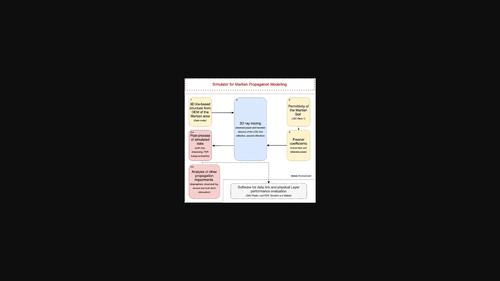当前位置:
X-MOL 学术
›
Int. J. Satell. Commun. Netw.
›
论文详情
Our official English website, www.x-mol.net, welcomes your feedback! (Note: you will need to create a separate account there.)
Design of a 3D ray-tracing model based on digital elevation model for comprehension of large- and small-scale propagation phenomena over the Martian surface
International Journal of Satellite Communications and Networking ( IF 1.7 ) Pub Date : 2021-09-21 , DOI: 10.1002/sat.1423 Stefano Bonafini 1 , Claudio Sacchi 1
International Journal of Satellite Communications and Networking ( IF 1.7 ) Pub Date : 2021-09-21 , DOI: 10.1002/sat.1423 Stefano Bonafini 1 , Claudio Sacchi 1
Affiliation

|
The aim of the scientific community, towards the investigation of solutions able to favor a futuristic human settlement on Mars, also concerns ad hoc communication systems and wireless networks to be deployed over the “Red planet.” However, the state-of-the-art appears to be missing of realistic and replicable models for understanding the radio propagation over precise Martian locations. This means that performing solid simulations, rather than roughly approximated ones, is really a tough task. Thus, this paper describes the design of a 3D ray-tracing simulator based on high-resolution digital elevation models (DEMs) for the evaluation of Martian large-scale and small-scale phenomena in the S and EHF bands. First, by taking advantage of the Cole–Cole equations, we computed the complex permittivity of the JSC Mars-1 Martian regolith simulant. Then, we developed a 3D tile-based structure of the Gale crater, thanks to its DEM, and finally, we implemented a ray-tracing algorithm for outdoor environments able to trace the line of sight (LOS), the first and second reflections of a radio frequency (RF) signal between a transmitter (TX) and a receiver (RX) over the 3D structure. The results focus on estimating path losses, shadowing values, outage probability, and on the parametrization of multipath channels for selected areas and subareas, presenting heavily different morphological features, of the Gale crater. Moreover, some brief considerations about dust storms and atmosphere harmful effects on propagation will be drawn.
中文翻译:

基于数字高程模型的 3D 射线追踪模型设计,用于理解火星表面的大尺度和小尺度传播现象
科学界的目标是研究能够有利于火星上未来人类住区的解决方案,还涉及将在“红色星球”上部署的特设通信系统和无线网络。然而,最先进的技术似乎缺少用于理解火星精确位置上的无线电传播的现实且可复制的模型。这意味着执行可靠的模拟,而不是粗略的近似模拟,确实是一项艰巨的任务。因此,本文描述了基于高分辨率数字高程模型 (DEM) 的 3D 射线追踪模拟器的设计,用于评估 S 和 EHF 波段的火星大尺度和小尺度现象。首先,利用 Cole-Cole 方程,我们计算了 JSC Mars-1 火星风化层模拟物的复介电常数。然后,由于其 DEM,我们开发了基于 3D 瓦片的 Gale 陨石坑结构,最后,我们为室外环境实施了一种光线追踪算法,能够追踪视线 (LOS)、无线电的第一次和第二次反射发射器 (TX) 和接收器 (RX) 在 3D 结构上的频率 (RF) 信号。结果侧重于估计路径损耗、阴影值、中断概率,以及对 Gale 陨石坑的选定区域和子区域的多径信道参数化,呈现出截然不同的形态特征。此外,还将简要考虑沙尘暴和大气对传播的有害影响。我们为室外环境实施了一种光线追踪算法,能够追踪视线 (LOS)、3D 结构上发射器 (TX) 和接收器 (RX) 之间射频 (RF) 信号的第一次和第二次反射. 结果侧重于估计路径损耗、阴影值、中断概率,以及对 Gale 陨石坑的选定区域和子区域的多径信道参数化,呈现出截然不同的形态特征。此外,还将简要考虑沙尘暴和大气对传播的有害影响。我们为室外环境实施了一种光线追踪算法,能够追踪视线 (LOS)、3D 结构上发射器 (TX) 和接收器 (RX) 之间射频 (RF) 信号的第一次和第二次反射. 结果侧重于估计路径损耗、阴影值、中断概率,以及对 Gale 陨石坑的选定区域和子区域的多径信道参数化,呈现出截然不同的形态特征。此外,还将简要考虑沙尘暴和大气对传播的有害影响。以及盖尔陨石坑的选定区域和子区域的多径通道参数化,呈现出截然不同的形态特征。此外,还将简要考虑沙尘暴和大气对传播的有害影响。以及盖尔陨石坑的选定区域和子区域的多径通道参数化,呈现出截然不同的形态特征。此外,还将简要考虑沙尘暴和大气对传播的有害影响。
更新日期:2021-09-21
中文翻译:

基于数字高程模型的 3D 射线追踪模型设计,用于理解火星表面的大尺度和小尺度传播现象
科学界的目标是研究能够有利于火星上未来人类住区的解决方案,还涉及将在“红色星球”上部署的特设通信系统和无线网络。然而,最先进的技术似乎缺少用于理解火星精确位置上的无线电传播的现实且可复制的模型。这意味着执行可靠的模拟,而不是粗略的近似模拟,确实是一项艰巨的任务。因此,本文描述了基于高分辨率数字高程模型 (DEM) 的 3D 射线追踪模拟器的设计,用于评估 S 和 EHF 波段的火星大尺度和小尺度现象。首先,利用 Cole-Cole 方程,我们计算了 JSC Mars-1 火星风化层模拟物的复介电常数。然后,由于其 DEM,我们开发了基于 3D 瓦片的 Gale 陨石坑结构,最后,我们为室外环境实施了一种光线追踪算法,能够追踪视线 (LOS)、无线电的第一次和第二次反射发射器 (TX) 和接收器 (RX) 在 3D 结构上的频率 (RF) 信号。结果侧重于估计路径损耗、阴影值、中断概率,以及对 Gale 陨石坑的选定区域和子区域的多径信道参数化,呈现出截然不同的形态特征。此外,还将简要考虑沙尘暴和大气对传播的有害影响。我们为室外环境实施了一种光线追踪算法,能够追踪视线 (LOS)、3D 结构上发射器 (TX) 和接收器 (RX) 之间射频 (RF) 信号的第一次和第二次反射. 结果侧重于估计路径损耗、阴影值、中断概率,以及对 Gale 陨石坑的选定区域和子区域的多径信道参数化,呈现出截然不同的形态特征。此外,还将简要考虑沙尘暴和大气对传播的有害影响。我们为室外环境实施了一种光线追踪算法,能够追踪视线 (LOS)、3D 结构上发射器 (TX) 和接收器 (RX) 之间射频 (RF) 信号的第一次和第二次反射. 结果侧重于估计路径损耗、阴影值、中断概率,以及对 Gale 陨石坑的选定区域和子区域的多径信道参数化,呈现出截然不同的形态特征。此外,还将简要考虑沙尘暴和大气对传播的有害影响。以及盖尔陨石坑的选定区域和子区域的多径通道参数化,呈现出截然不同的形态特征。此外,还将简要考虑沙尘暴和大气对传播的有害影响。以及盖尔陨石坑的选定区域和子区域的多径通道参数化,呈现出截然不同的形态特征。此外,还将简要考虑沙尘暴和大气对传播的有害影响。

























 京公网安备 11010802027423号
京公网安备 11010802027423号